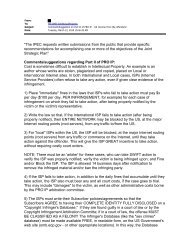We Energies Coal Combustion Products ... - The White House
We Energies Coal Combustion Products ... - The White House
We Energies Coal Combustion Products ... - The White House
Create successful ePaper yourself
Turn your PDF publications into a flip-book with our unique Google optimized e-Paper software.
General Road Performance<br />
<strong>The</strong> surface of the concrete road was inspected initially and found to be in<br />
competent condition, free of substantial ruts, cracking and other signs of<br />
pavement distress. <strong>The</strong> pavement was observed again after spring thaw and<br />
found to be in good condition. This indicated that the subgrade performed<br />
satisfactorily through the first winter.<br />
It was concluded that the PPPP bottom ash materials are well suited for use as<br />
general structural fill in road subgrade preparations or below structural<br />
elements. Based on field observations, it was recommended to use bottom ash<br />
in a 2 to 1 thickness ratio compared to conventional base course material, to<br />
enhance the performance of the pavements. <strong>The</strong> reason for this<br />
recommendation is the lesser degree of stiffness of the bottom ash. It was<br />
concluded that in well-drained pavement sections, bottom ash base course (in<br />
the recommended thickness) should perform well.<br />
Bottom Ash as Base Course Aggregate for<br />
Flexible Pavement Sections<br />
<strong>The</strong> earlier study evaluated the performance of bottom ash as a base course<br />
material for a rigid pavement section. Though the pavement section performed<br />
well, a rigid pavement was used in that study and the performance of that<br />
section cannot be assumed to represent the behavior of less rigid pavement<br />
sections. Hence, a second pilot study was undertaken to evaluate the use of<br />
bottom ash for conventional base course aggregate in a flexible pavement<br />
section, such as parking lots and bituminous-paved roads (44).<br />
A.W. Oakes & Son had observed that the actual performance of bottom ash in<br />
constructed haul roads was excellent. From this experience, they suggested<br />
that the ash might be effective at lesser thicknesses than recommended in the<br />
original study performed by STS Consultants, Ltd. A.W. Oakes & Son<br />
suggested that a pavement section consisting of 4” – 6” of bottom ash over<br />
4” – 6” of open-graded crushed stone would serve as an excellent base for a<br />
heavy duty asphalt pavement.<br />
Pavement Construction<br />
A failed section of pavement 24 ft. wide by 55 ft. long located at the entrance<br />
drive of A.W. Oakes & Son Land Reclamation Landfill Facility in Racine,<br />
Wisconsin, was replaced with 4¾” of bituminous concrete pavement placed<br />
over 4½” – 6½” of bottom ash which was over 8” of an open-graded crushed<br />
stone base layer. <strong>The</strong> test section was constructed in November and December<br />
of 1993. Field density tests were performed by STS Consultants on the inplace<br />
bottom ash and on the in-place bituminous pavement using a nuclear<br />
density meter (44).<br />
<strong>We</strong> <strong>Energies</strong> 164<br />
<strong>Coal</strong> <strong>Combustion</strong> <strong>Products</strong><br />
Utilization Handbook



